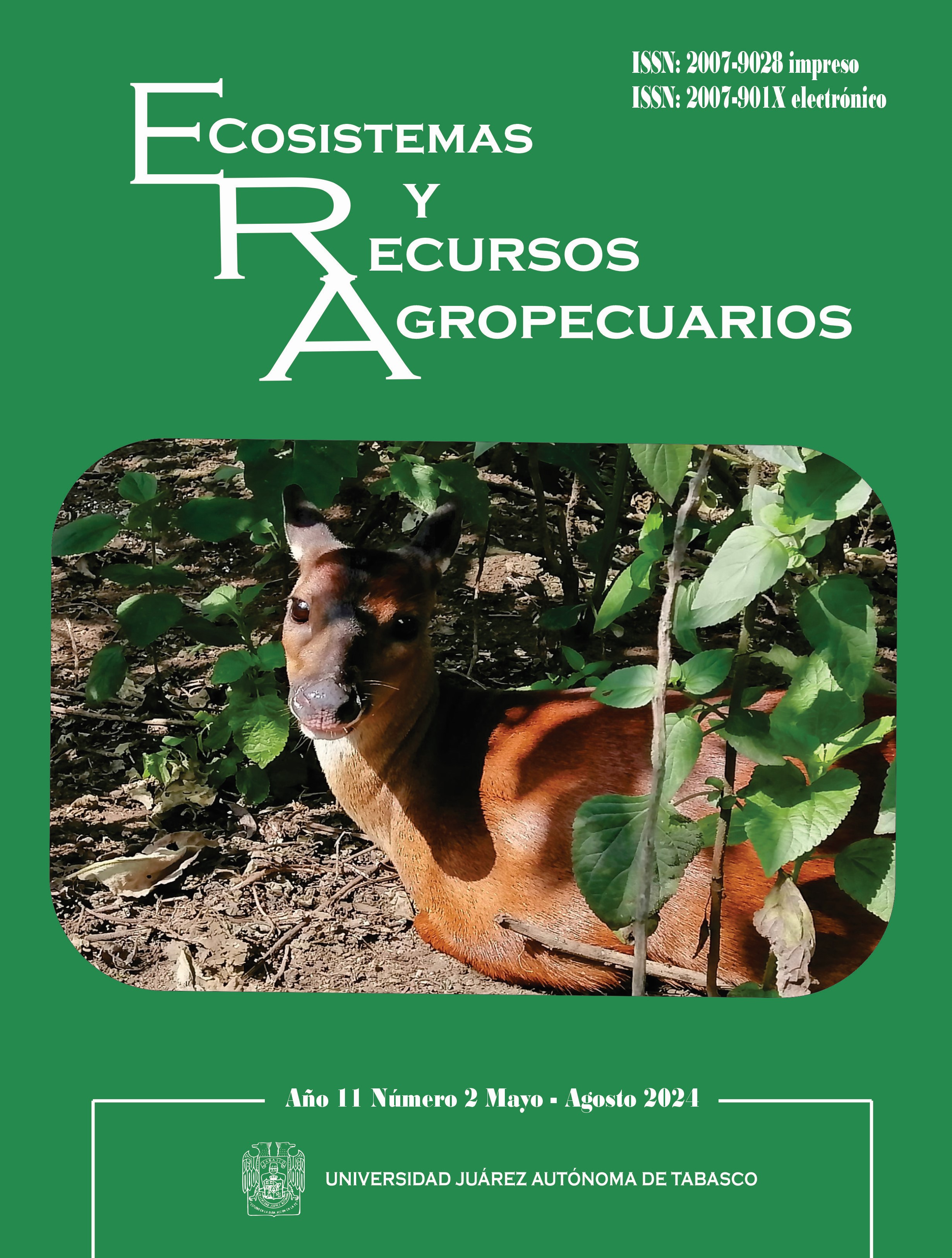Impact of climate change on coffee production in Veracruz under a Ricardian approach
DOI:
https://doi.org/10.19136/era.a11n2.3896Keywords:
Land value, income, vulnerability, climatic variables, adaptationAbstract
The phenomenon of climate change has generated significant adverse consequences on coffee productivity and the income of producers around the world. The present study aims to evaluate the potential repercussions of climate change on coffee production in the Las Montañas region, Veracruz. To carry out this analysis, socioeconomic and environmental data were collected during the years 2022 and 2023, through a survey applied to a sample of 91 production units specialized in coffee cultivation. These data were subjected to ordinary least squares analysis, using the Ricardian approach. The results obtained indicate that the climate change will have a significant impact on the value of the land and that these effects will be differentiated between the different strata of producers, particularly affecting the smaller scale ones. The heterogeneity in climate sensitivity highlights the importance of considering specific strategies for different types of producers in order to reduce their dependence on coffee cultivation and reduce their vulnerability to the increasingly evident impacts of climate change.
Downloads
References
Abanega A, Mohammed A (2021) Impact of small-scale irrigation schemes on smallholders household income and food security in Ethiopia: Review. Journal of Biology, Agriculture and Healthcare 11(1): 40-45.
Ajetomobi J, Abiodun A, Hassan R (2011) Impacts of climate change on rice agriculture in Nigeria. Tropical and Subtropical Agroecosystems 14: 613-622.
https://www.revista.ccba.uady.mx/ojs/index.php/TSA/article/view/689
Arcila J (2007) Crecimiento y desarrollo de la planta de café. Sistemas de producción de café en Colombia. Cenicafé. Caldas, Colombia: 310p. http://hdl.handle.net/10778/720
Baca M, Läderach P, Haggar J, Schroth G, Ovalle O (2014) An Integrated Framewortk for Assessing Vulnerability to Climate Change and Developing Adaptation Strategies for Coffee Growing Families in Mesoamerica. Open One 9(2): 1-11. DOI: https://doi.org/10.1371/journal.pone.0088463
Ballinas M, Esperón M, Barradas V (2015) Estimating evapotranspiration in the central mountain region of Veracruz, México. Bosque 36(3): 445-455. DOI: 10.4067/S0717-92002015000300011
Bunn C, Läderach P, Ovalle Rivera O, Kirschke D (2015) A bitter cup: climate change profile of global production of Arabica and Robusta coffee. Climatic Change 129: 89-101. DOI: 10.1007/s10584-014-1306-x
Canet G, Soto C (2016) Capítulo I. Panorama general de la caficultura en Latinoamérica. En Canet G, Soto C, Víquez P, Ocampo J, Rivera A, Navarro G, Guatemala M, Villanueva S. La situación y tendencias de la producción de café en América Latina y el Caribe. IICA/CIATEJ. Costa Rica. pp: 1-20.
Craparo A, Van Asten P, Läderach P, Jassogne L, Grab S (2015) Coffea arabica yields decline in Tanzania due to climate change: Global implications. Agricultural and Forest Meteorology 207: 1-10. DOI: http://dx.doi.org/10.1016/j.agrformet.2015.03.005
Descroix F, Snoeck J (2004) Environmental Factors Suitable for Coffee Cultivation. En Wintgens J. Coffee: Crowing, Processing, Sustuinuchle Productioli. WILEY-VCH Verlag CmbH & Co. KCaA. pp: 164-177. DOI: https://doi.org/10.1002/9783527619627.ch6
Estrada F, Mendoza A, Calderón O, Botzen W (2022) Impacts and economic costs of climate change on Mexican agriculture. Regional Environmental Change 22(126): 1-16. DOI: https://doi.org/10.1007/s10113-022-01986-0
Falco C, Galeotti M, Olper A (2019) Climate change and migration: Is agriculture the main channel? Global Environmental Change 59:1-26. DOI: https://doi.org/10.1016/j.gloenvcha.2019.101995
FIRA (2015) Panorama Agroalimentario. Café 2015. FIRA. 39p.
Fournier L, Di Stefano J (2004) Variaciones climáticas entre 1988 y 2001, y sus posibles efectos sobre la fenología de varias especies leñosas y el manejo de un cafetal con sombra en ciudad Colón de Mora, Costa Rica. Agronomía Costarricense 28(01): 101-120. https://www.redalyc.org/articulo.oa?id=43628110
Fries A, Rollenbeck R, Nauß T, Peters T, Bendix J (2012) Near surface air humidity in a megadiverse Andean mountain ecosystem of southern Ecuador and its regionalization. Agricultural and Forest Meteorology 152: 17-30. DOI: 10.1016/j.agrformet.2011.08.004
García C, Gómez F, Bruno A, Rosas A, Servin R, Muños R (2018) Identificación de elementos identitarios en la región de las altas montañas de Veracruz. Agroproductividad 11(8): 95-100. DOI: https://doi.org/10.32854/agrop.v11i8.1103
Gay C, Estrada F, Conde C, Eakin H, Villers L (2006) Potential impacts of climate change on agriculture: a case of study of coffee production in Veracruz, Mexico. Climate Change 79: 259–288. DOI: 10.1007/s10584-006-9066-x
Guerrero J., Jaramillo JL, Mora J, Bustamante A, Vargas S, Chulim N (2020) Impacto del cambio climático sobre la producción de café. Tropical and Subtropical Agroecosystems 23(71): 1-18. DOI: http://dx.doi.org/10.56369/tsaes.3288
Imbach P, Fung E, Hannah L, Navarro C, Roubik D, Ricketts T, Roahrdanz, P (2017) Coupling of pollination services and coffee suitability under climate change. PNAS 114(39). 10438-10442. DOI: www.pnas.org/cgi/doi/10.1073/pnas.1617940114
Jaramillo-Villanueva JL, Guerrero-Carrera J, Vargas-López S, Bustamante-González A (2021) Use of agricultural technology, yields and economic profitability of small-scale producers (Coffea arabica L.). Agro-Productividad: 1-8. DOI: https://doi.org/10.32854/
Jawid A. (2020). A Ricardian Analysis of the Economic Impact of Climate Change on Agriculture: Evidence from the Farms in the Central Highlands of Afghanistan. Journal of Asian Economics 67: 1-16. DOI: https://doi.org/10.1016/j.asieco.2020.101177
Jurado Celis S (2017) De la parcela a la mesa. El trabajo de las mujeres en torno a la pequeña producción de café en Oaxaca, México. Revista latinoamericana de antropología del trabajo 1(1): 1-25. http://www.ceil-conicet.gov.ar/ojs/index.php/lat/article/view/240
Kurukulasuriya P, Mendelsohn R (2008) A Ricardian nalysis of the impact of climate change on African cropland. AfJARE 2(1): 1-23. DOI: 10.22004/ag.econ.56965
Läderach P, Ramírez-Villegas J, Navarro-Racines C, Zelaya C, Martínez-Valle A, Jarvis A (2017) Climate change adaptation of coffee production in space and time. Climate Change 141: 47-62. DOI: 10.1007/s10584-016-1788-9
Malhi G, Kaur M, Kaushik P (2021) Impact of climate change on agriculture and its mitigation strategies: A review. Sustainability 13(1318): 1-21. DOI: https://doi.org/10.3390/su13031318
Mendelsohn R (2009) The Impact of Climate Change on Agriculture in Developing Countries. Journal of Natural Resources Policy Research 1(1): 5-19. DOI: 10.1080/19390450802495882
Mendelsohn R, Dinar A (2009) Climate Change and Agriculture. An economic analysis of global impacts, adaptation and distributional effects. World Bank. Massachusetts, USA. 225p.
Mendelsohn R, Arellano-Gonzalez J, Christensen P (2009) A Ricardian analysis of Mexican farms. Environment and Development Economics 15: 153-171. DOI: 10.1017/S1355770X09990143
Mendelsohn R, Nordhaus W, Shaw D (1994) The Impact of Global Warming on Agriculture: A Ricardian Analysis. The American Economic Review 84(4): 753-771. DOI: 10.1257/aer.89.4.1053
Moguel P, Toledo V (1999) Café, luchas indígenas y sostenibilidad. El caso de México. Primer Seminario Internacional de Caficultura Orgánica 18: 23-36. https://www.jstor.org/stable/20743031
Monterroso A, Fernández A, Trejo R, Conde A, Escandon J, Villers L, Gay C (2014) Vulnerabilidad y adaptación a los efectos del cambio climático en México (Primera Edición ed.). Universidad Nacional Autónoma de México. DCMX. 664p. https://atlasclimatico.unam.mx/VyA/
Mora J, Ramírez D, Ordaz J, Acosta A, Serna B (2010) Efectos del cambio climático sobre la agricultura. CEPAL. México. 74p. https://hdl.handle.net/11362/25926
Nor Diana M, Zulkepli N, Siwar C, Zainol M (2022) Farmers’ Adaptation strategies to climate change in Southeast Asia: A systematic literature review. Sustainability 14(3639): 1-15. DOI: https://doi.org/10.3390/su14063639
Raihan A, Tuspekova A (2022) Towards sustainability: Dynamic nexus between carbon emission and its determining factors in Mexico. Energy Nexus 8: 1-12. DOI: https://doi.org/10.1016/j.nexus.2022.100148
Rivera M, Nikolskii I, Castillo M, Ordaz V, Díaz G, Guajardo R (2013) Vulnerabilidad de la producción del café (Coffea arabica L.) al cambio climático global. Sociedad Mexicana de la Ciencia del Suelo, A.C. 31(4): 305-313. DOI: http://www.redalyc.org/articulo.oa?id=57329629005
Ruiz LE, (2015) Adaptive capacity of small-scale coffee farmers to climate change impacts in the Soconusco region of Chiapas, Mexico. Climate and Development 7(2): 100-109. DOI: http://dx.doi.org/10.1080/17565529.2014.900472
Schroth G, Laderach P, Dempewolf J, Philpott S, Haggar J, Eakin H, et al. (2009). Towards a climate change adaptation strategy for coffee communities and ecosystems in the Sierra Madre de Chiapas, Mexico. Mitigation and Adaptation Strategies for Global Change 14: 605-625. DOI: 10.1007/s10113-014-0713-x
Toledo V, Barrera N (2017) Political Agroecology in Mexico: A Path toward Sustainability. Sustainability 9(268): 1-13. DOI: 10.3390/su9020268
Villers L, Arizpe N, Orellana R, Conde C, Hernández J (2009) Impactos del cambio climático en la floración y desarrollo del fruto del café en Veracruz, México. Interciencia 34(5): 322-330. DOI: 0378-1844/09/05/322-08
Waha K, Zipf B, Kurukulasuriya P, Hassan R (2016) An agricultural survey for more than 9,500 African households. Scientific Data 3(160020): 1-8. DOI: 10.1038/sdata.2016.20
Downloads
Published
Issue
Section
License
Copyright (c) 2024 Ecosistemas y Recursos Agropecuarios

This work is licensed under a Creative Commons Attribution-NonCommercial-ShareAlike 4.0 International License.
Aviso de copyright
Los autores que se envían a esta revista aceptan los siguientes términos:
una. Los autores conservan los derechos de autor y garantizan a la revista el derecho a ser la primera publicación del trabajo con una licencia de atribución de Creative Commons que permite a otros compartir el trabajo con un reconocimiento de la autoría del trabajo y la publicación inicial en esta revista.
B. Los autores pueden establecer acuerdos complementarios separados para la distribución no exclusiva de la versión del trabajo publicado en la revista (por ejemplo, en un repositorio institucional o publicarlo en un libro), con un reconocimiento de su publicación inicial en esta revista.
C. Se permite y se anima a los autores a difundir su trabajo electrónicamente (por ejemplo, en repositorios institucionales o en su propio sitio web) antes y durante el proceso de envío, ya que puede conducir a intercambios productivos, así como a una cita más temprana y más extensa del trabajo publicado. (Consulte El efecto del acceso abierto).


